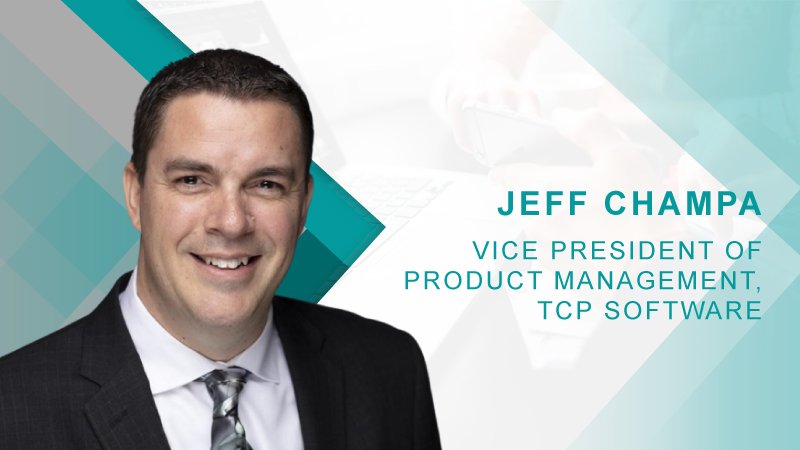Greetings Jeff,
Brief us about TCP Software and give us an overview of how its solutions help organizations work better.
For 35 years, TCP Software has helped organizations engage their people by providing flexible, mobile timekeeping, scheduling, and integrated workforce management solutions. Trusted by over 30,000 customers and millions of users, TCP delivers best-in-class technology and personalized support to organizations of all sizes in the public and private sectors to meet their complex time tracking, employee scheduling, leave management, and other workforce needs.
Founded in 1988 to help solve time and attendance challenges for the restaurant industry, TCP has grown into a comprehensive workforce management system that helps tens of thousands of organizations optimize operations and streamline processes.
Since 2020, TCP has expanded its corporate portfolio through acquisitions, adding several innovative solutions to its portfolio. These acquisitions include Humanity (formerly Shift Planning), Aladtec, InstaSub (formerly Subzz), and ScheduleAnywhere which collectively have added robust technical capabilities to TCP’s portfolio, expanding the depth and breadth of the company’s scheduling solutions. Whether delivered separately or combining a collection of these technologies, TCP provides proven workforce management solutions designed to optimize daily processes and uplevel the employee experience, empowering entire workforces to work better.
How does TCP Software’s mission support customers?
At its core, TCP Software provides automated time, attendance, and scheduling solutions to help organizations work more efficiently. For more than three decades, TCP Software has provided premier employee time, attendance, and scheduling solutions, meeting the needs of customers with scalable software and hardware designed to help administrators schedule employees, manage labor costs, and reduce compliance risk. TCP’s configurable solutions include time and attendance, document management, reporting and analytics, and AI-powered scheduling, all of which integrate with major ERP, HCM, and payroll systems as well as an extensive portfolio of time collection devices.
Our solutions help organizations of all sizes in the public sector and private sectors (in a range of industries including K-12 and higher ed, public safety, Healthcare, Manufacturing, Hospitality, and Retail).
Being a technology leader, how do you strategize to further TCP’s mission and vision?
As a product management professional, my main objective is to design and develop product features that more seamlessly integrate into employees’ lives. My job is done successfully when TCP’s solutions empower our customers and their employees, enabling people to work more effectively and efficiently. At TCP, customer-centricity is at the heart of everything we do. We strive to help people work better.
For me, that means having a deep understanding of who our customers are and the workforce management challenges they face. Working in technology, I’ve found the Pragmatic Marketing Framework useful as this approach has taught me to listen closely to the market which will then guide decisions, prioritize projects and drive results. Once I understand the unique needs of our customers, I’m then able to design solutions that solve those critical pain points. Even after evaluating which problems our products can solve and identifying new solutions, we proactively talk to customers and gather feedback. This helps ensure we continuously improve our offerings and adapt to the market’s rapidly changing needs.
A great example of this occurred during the COVID-19 pandemic when we heard from customers who operated manufacturing facilities and other operations that required employees to work on-site. Management at these companies was concerned for the health and safety of workers as employees were required to self-report their temperature and any COVID-19 symptoms. Knowing the various concerns customers were facing related to safety and compliance, we designed an add-on to our modular time clock with a touchless thermal sensor and an attestation question asking whether the employee had any recent exposure to COVID-19.
The combination of these features gave customers peace of mind that they were protecting their workforce by implementing routine temperature scans while also ensuring that each individual employee was participating by tracking health screening based on the employee’s fingerprint. By recognizing customer needs, our team was able to take action and build a time clock that ensures the health, safety, and well-being of the workforce we serve. To me, this is a great example of designing technology to empower customers and remove some of the burdens from their shoulders.
In today’s rapidly changing network, how is TCP providing organizational leaders and managers with the insights they need to manage day-to-day operations?
At TCP, we take great pride in providing customers with a gold mine of workforce data at their fingertips. Regardless of size and industry, organizations need effective and insightful business reporting to operate successfully and make informed, timely decisions. From business leaders to Payroll and HR departments, reporting and analytics are the cornerstone of a well-run organization. TCP Analytics helps customers reduce costs, manage compliance, and stimulate growth.
We know that with data that’s easier to access, display, and consume, our customers will make better decisions faster that solve problems and keep them moving toward their goals. So to us, more data is better. We provide customers with 200 standard reports and dashboards in addition to advanced analytics capabilities for users that need to build customized dashboards. Standard reports, default dashboards, advanced reporting capabilities. Our robust reporting capabilities empower data maturity.
With the launch of TCP Analytics, our most robust reporting capability yet, earlier in the year, we’ve empowered front-line managers to create their own custom reports and dashboard tools. This allows them to track data and KPIs relevant to their work.
1. Track KPIs and make insights actionable: Automate report building and eliminate manual KPI tracking projects to free up valuable resources, reduce errors, and eliminate latency.
2. Quickly see trends: Track overtime trends and take action to reduce labor costs and/or level load the schedule.
3. Get the right data to the right people at the right time: Unlock and connect the information needed to run an organization with the tools already in use, saving valuable time and money.
What is your opinion on aligning technological advancements like AI and ML for managing day-to-day operations?
Regardless of whether you use, or have even heard of ChatGPT, AI, machine learning, and natural language processing surround us. And many of us use these technologies every day without even realizing it. Have you ever used Google Maps, Alexa, or Siri, bought something that Google or Amazon recommended, watched a show that Netflix recommended, or even used autocorrect? You’ve probably used all of these at some point, maybe even on a daily basis. AI, machine learning, and natural language processing are already embedded into our decision processes.
These technologies have already proven to be valuable in our lives outside of work, and even though today’s applications for business are just scratching the surface of each technology’s potential, the results are already impressive. An Accenture study recently found that nearly 75% of companies have already integrated AI technology into their business strategies, with 42% of companies using AI reporting that the ROI from AI usage exceeded their expectations.
While AI, machine learning, and natural language processing are still relatively in their infancy, all three technologies are already having an impact on a range of business applications. These technologies are solving pressing business challenges, including driving significant productivity and efficiency gains while also helping workforces develop new skills. For instance, AI-powered micro-learning is helping employees build new skills. AI-driven companies have found that small doses of training on very specific topics are being retained when combined with personalized AI learning boosters that remind employees about what they learned at various intervals post-training.
On the talent acquisition end, these technologies assess candidates’ skills and resumes—replacing an extremely laborious task—while also scheduling interviews with candidates. Leveraging technology for these tasks empowers organizations to leverage their talent acquisition personnel for more strategic and valuable activities. Meanwhile, AI and machine learning are being used to analyze employee sentiment across an organization. Following employee engagement surveys, these technologies can review responses to open-ended questions and develop trends surrounding the sentiment of employee feedback. This allows organizations to better understand how employees are feeling, apply that to the business, and use that intel to make various decisions designed to reduce churn.
In my world of workforce management, AI and machine learning take the complexity and risk out of schedule. The power of these technologies is their ability to eliminate errors and unfairness, while also seamlessly managing all time off requests, regulations, and complex requirements.
Labor compliance is a huge headache for companies that employ minors or even specialty groups like nurses, EMTs, police, and firefighters who must maintain a certain number of hours off the job in between shifts. Failure to comply comes with heavy fines, yet noncompliance often results from unintentional human error given the complexity of these scheduling rules.
With AI, companies can automate highly complex and regulated scheduling needs, allowing them to set rules for the scheduling tool that eliminate the likelihood of errors that violate labor laws. AI-driven scheduling can also be used to forecast demand and build staffing plans designed to meet expected surges. Powerful AI detects staffing trends based on historical performance and business metrics to forecast future scheduling demand. It then can build a staffing plan, recommend shifts, and ultimately, develop a schedule with shifts assigned to employees.
How has the integration of these technologies, transformed the face of the industry?
As each of these technologies becomes more pervasive, there is a wealth of incremental value in leveraging AI, machine learning, and natural language processing to drive efficiencies and competitive advantage. Organizations are making investments in these technologies to achieve a return. The same Accenture study found that 69% of companies surveyed that had implemented some form of a chatbot reported that in turn, they saved on operational costs.
Cost reduction is a huge benefit of these technologies, and so too is efficiency. By reallocating time-intensive tasks, like customer service and data analysis, to technology, organizations are empowered to use their people for more strategic work.
While these technologies will have a massive impact on productivity, organizations integrating these technologies must also be strategic in how they manage, train, and measure the performance of these investments. All three of these technologies are trained algorithms that need occasional recalibration to optimize their performance. It’s critical to reinvest some of the time saved by leveraging these technologies to check their work and share feedback with the vendor.
For instance, if leveraging AI to review and analyze resumes, periodically a team member should review the resumes that didn’t fit its criteria to determine if there’s a high occurrence of qualified resumes being rejected. If false negatives are occurring at a high rate, the AI will need better training in order to perform adequately. To ensure you’re receiving as much value as possible from these investments, you must periodically measure the results to confirm that these technologies are continually analyzing and operating correctly.
Meanwhile, your work is not done once you take a more hands-on approach to managing and training these technologies. Organizations must also identify their starting point in the processes being driven by different technologies so they can identify if there’s been an improvement, and ultimately, ROI.
Discover the full potential of your Hrtech strategy with our comprehensive Hrtech News and Hrtech Interviews.
Want to Contribute? CLICK HERE To Submit Your Guest Post and Join Our Community of Writers!!!

Jeff Champa Vice President of Product Management, TCP Software
Jeff Champa is the Vice President of Product Management at TCP Software, where he leads the overall vision and growth of TCP's solutions. As an innovative leader in Product Management, Jeff is entrusted with shaping the future of the organization’s workforce management product offerings. Prior to his role at TCP, Jeff held leadership roles at Lexipol, ORBCOMM, Omnitracs, and Rand McNally. With over 20 years of experience, Jeff has a wealth of knowledge about technology and how organizations use it to transform their processes and employee experiences.

